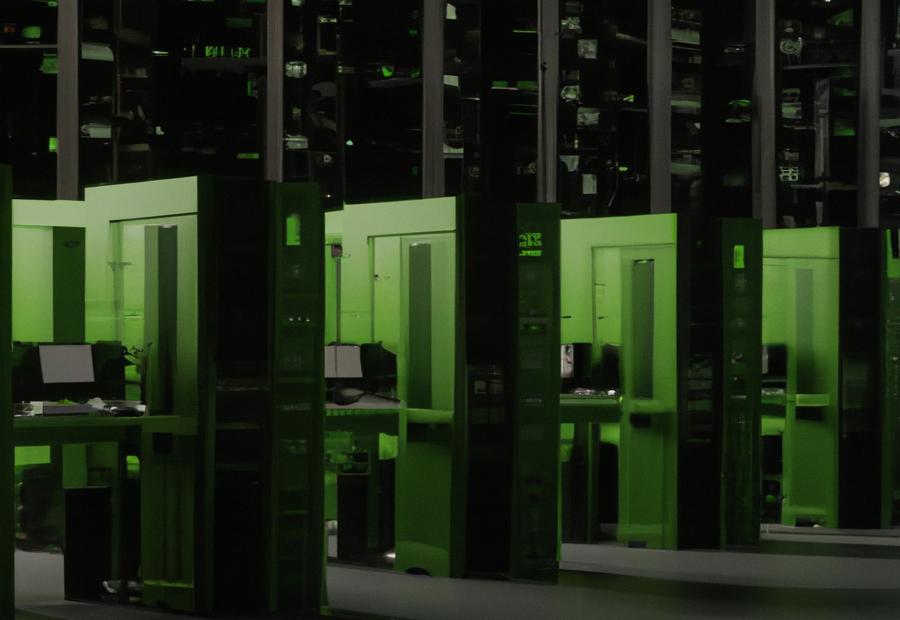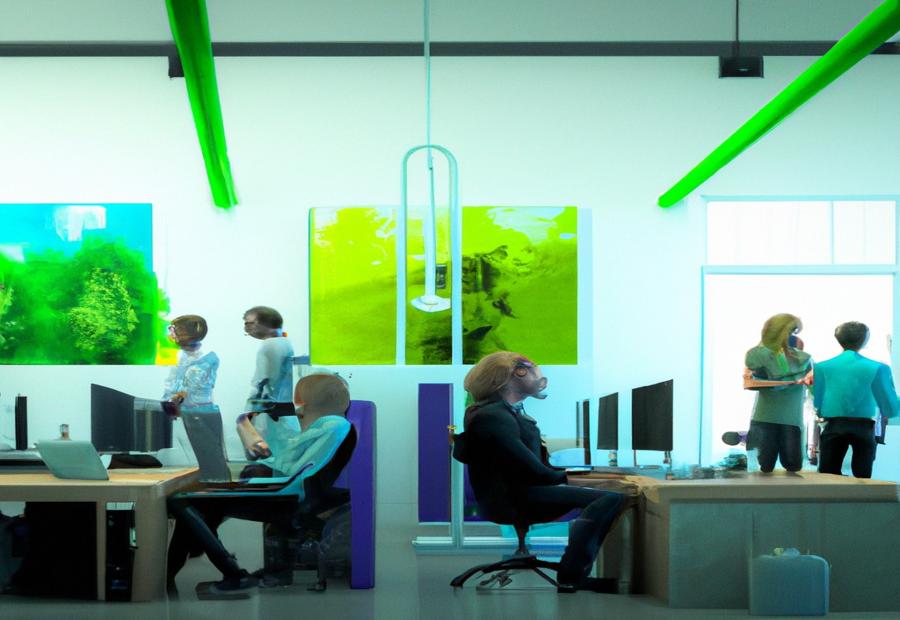Key Takeaways:
- Green IT can help businesses understand and optimize the impact of software on the environment, improving how they manage their operations and resources.
- Many companies still have room to improve energy efficiency in their everyday processes and going green can positively influence employees, profits, and the planet, even if it costs more initially.
- Green computing involves environmentally friendly software, hardware, networks, systems, applications, and practices. It has three main complementary approaches: Greener IT, A Greener World Through IT, and Green Awareness.
- Greener IT aims to re-engineer IT products and practices to improve energy efficiency, maximize use, reduce carbon footprint, and meet environmental compliance requirements.
- A Greener World Through IT deploys IT to establish a sustainable environment in sectors such as business, energy, manufacturing, agriculture, healthcare, and construction.
- Green Awareness uses IT to promote green initiatives and raise awareness about the serious impact of climate change.
- Green technology benefits both the environment and businesses by reducing waste and costs, improving brand image and attracting customers, increasing productivity and employee satisfaction, complying with regulations and avoiding penalties, and future-proofing the business.
- Cost reduction is a significant benefit of going green in the workplace. Green technology can reduce energy, water, and paper waste, and switching to a paperless system saves money and reduces the company’s carbon footprint.
- The impact of digital technology on greenhouse gas emissions is significant, and developing green IT strategies is essential in reducing environmental impact. This includes raising awareness among employees, tracking and reporting on carbon and water consumption, reducing the number of devices, using virtual meetings, recycling and reusing tech products, going paperless, and optimizing data centers for energy efficiency.
- Green IT aims to minimize negative effects on the environment by designing, manufacturing, operating, and disposing of computer-related products in an eco-friendly manner. Compliance is another reason for the importance of green IT as businesses are under pressure to reduce their environmental impact.
- Green IT is important for climate change as enterprise IT emits a lot of greenhouse gases and contributes to climate change. It can be a useful part of broader climate strategies in companies.
Introduction to Green IT Solutions

Photo Credits: Terminl.Ca by Nicholas Miller
Green IT Solutions are becoming trendy for businesses. They optimize operational efficiency and reduce environmental impact. Companies can choose from energy-efficient hardware, software, virtualization, cloud computing, and telecommuting. These solutions save costs and enhance productivity by streamlining processes.
Renewable energy sources like solar, wind, and hydro power can power data centers and other IT facilities. Companies can also reduce waste and promote resource efficiency with practices like e-waste recycling, digitization, and paperless workflows. This lessens emissions and waste generation.
To maximize Green IT Solutions, businesses need an integrated strategy that aligns with their goals and values. Energy audits, environmental impact measuring, targets, and benchmarks help businesses create a holistic approach. This enhances their competitiveness, brand value, and long-term viability.
Importance of Green IT for Businesses

Photo Credits: Terminl.Ca by Gerald Carter
Businesses are becoming more eco-friendly. Thus, green IT solutions are essential. By using energy-efficient servers and monitors, virtualizing, and reducing paper usage with digital files, businesses can lower their carbon footprint, save on energy costs, and reduce waste.
Green IT practices benefit businesses. They can save money on utilities, get tax incentives, and reinvest in their operations. In addition, green IT can improve workflows and productivity, leading to higher profits.
The global green IT solutions market was valued at $6.2 billion in 2019. This is expected to grow to $13 billion by 2026. Green IT solutions are increasingly important and have potential for growth.
Benefits of Adopting Green Technology in the Workplace

Photo Credits: Terminl.Ca by George Williams
Adopting green technology in the workplace can offer a range of benefits, both for the environment and for businesses themselves. In this section, we’ll explore the diverse advantages of adopting green technology. From reducing waste and costs, improving brand image, and increasing productivity and employee satisfaction to compliance with regulations and future-proofing the business, we’ll examine the various reasons why businesses should consider going green.
Reducing Waste and Costs
It’s a must for companies to use green IT solutions. Doing so reduces waste and costs. Greener technologies benefit businesses financially and environmentally. There are many ways to save money and the environment.
For example, video conferencing replaces business travel. It saves costs and emissions. Reusing tech products, like computers, phones, and printers, cuts new equipment costs and e-waste. Going paperless saves money and printing. Optimizing data centers lowers electricity and utility bills.
Encouraging employees to turn off computers or recycle promotes responsible consumption. Also, raise awareness of eco-friendly behaviors. A great example is Staples office supply chain. They cut paper usage by 20% and saved $4 million in paper expenses.
Green IT strategies have positive environmental and financial benefits. Being eco-friendly attracts customers and builds a strong brand image. Going green is smart business.
Improving Brand Image and Attracting Customers
Businesses are recognizing the importance of environmental sustainability, to improve their brand image and draw in customers. Demonstrating commitment to environmental responsibility can make a company appear socially responsible and boost its reputation.
Using sustainable practices can appeal to eco-conscious customers, resulting in higher loyalty, sales figures, and reputation. It’s becoming a major factor for consumers when buying.
Green IT solutions let companies stand out in a competitive market. It also shows a practical approach to the planet’s wellbeing. Regulators appreciate this, as they become stricter on emissions regulations. Companies can avoid penalties and show compliance with governmental guidelines.
Green IT strategies help the environment, and also improve employee productivity and satisfaction. Adopting sustainable practices through green IT solutions is an effective way to boost brand image and attract customers.
Increasing Productivity and Employee Satisfaction
Green IT solutions are a great way for businesses to improve productivity and employee satisfaction. By reducing waste and energy consumption, it creates a healthier and sustainable work environment. This not only benefits employees but also contributes to job satisfaction.
In addition, green IT practices can offer other advantages. For example, telecommuting or remote work options. This reduces carbon emissions, offers flexibility in work schedules and helps avoid lengthy commutes. Sustainable practices can also contribute to a sense of purpose and values alignment.
Businesses must recognize the connection between sustainability and employee satisfaction. By prioritizing employee well-being and engagement through green IT, companies will ultimately boost productivity and foster a strong company culture. A report by the Carbon Trust states 81% of office workers would like employers to commit to sustainability. This shows the increasing demand from employees for organizations to prioritize sustainability.
Compliance with Regulations and Avoiding Penalties
Green IT tech is a must for businesses to follow environmental regulations and avoid penalties. Many countries have laws, directives, and rules to reduce energy consumption. Companies not following these laws could face serious consequences.
Green IT can optimize energy use and lower costs of power, water, fuel, and gas storage. Businesses must adopt green IT strategies to stay in compliance and sidestep penalties. Environmentally-friendly hardware and software, such as cloud computing and virtual meetings, can reduce carbon emissions.
Moreover, green IT strategies can attract customers worried about climate change. Companies that use green tech can improve their brand image, leading to more trust, higher profits, and greater sustainability.
Businesses have an important job to make sectors better and green IT tech is needed. This isn’t only responsible but also safeguards the planet’s future. It helps address challenges faced by millennials, such as habitat destruction, resource depletion, and climate change.
Future-proofing the Business and Staying Ahead of Competitors
Green IT solutions are essential for businesses to stay ahead. They reduce waste and costs, improve brand image, and attract customers. Plus, they make sure the company meets regulations.
The benefits don’t end there. Implementing green IT strategies impacts the business’s bottom line by reducing environmental impact. Organizations can raise awareness about sustainability, track carbon and water consumption, reduce devices, have virtual meetings, recycle tech products, go paperless, and optimize data centers.
Staying on top of sustainable practices will help the business stay long-term viable and help prevent climate change. This is especially important now as companies must adapt to changing conditions. To future-proof themselves, businesses must keep an eye on sustainable practices.
Ways to Implement Green IT Strategies

Photo Credits: Terminl.Ca by Vincent Rodriguez
Implementing green IT strategies can not only make businesses more efficient but also contribute to a greener world. In this section, we’ll discuss different ways to implement green IT strategies. From implementing greener technologies to raising green awareness, we have a wealth of options to choose from to reduce our carbon footprint and move towards a more sustainable future.
Greener IT
Green IT practices involve using energy-efficient technologies and responsibly disposing of electronic waste, all with an aim to minimize environmental damage. By utilizing green IT strategies, businesses can enhance efficiency while cutting back on waste, costs, and carbon emissions. Plus, it gives a boost to their brand image, attracts more customers, and keeps them ahead of competitors.
To implement green IT procedures, businesses can try virtual meetings as an alternative to physical travel. This not only reduces carbon emissions, but it also saves time and money, and increases productivity. Moreover, recycling and reuse of tech products lessens environmental impact while producing revenue via refurbished sales or donations to non-profits. Also, going paperless by using digital workflows helps in lowering costs connected to printing, mailing, storage, and disposal of physical documents.
An important part of successful implementation of green IT practices is employee awareness. Measuring carbon and water consumption metrics can help in monitoring progress towards sustainability goals and motivate employees to join green initiatives. Consolidating or virtualizing devices can save plenty of energy, improve performance and security, and optimize data centers for energy efficiency. This includes using advanced cooling systems, power management software, renewable energy sources, and server consolidation techniques. By adopting and executing these greener IT practices, companies can positively affect the environment, upgrade efficiency and costs, and uphold corporate sustainability objectives.
A Greener World Through IT
To create a more sustainable world, businesses must incorporate green tech. By implementing eco-friendly systems and practices, companies can reduce their environmental footprint. Strategies such as virtual meetings, recycling tech products and going paperless can help reduce waste and optimize energy. Raising employee awareness of sustainability can also promote greener habits.
Data centers are key to business sustainability. Optimizing data centers for energy efficiency is vital for reducing environmental impact while keeping business operations running.
Adopting green solutions has positive effects on businesses. It boosts brand image, increases productivity among employees, and helps conform to regulations.
It is essential to prioritize the planet alongside economic goals. Going green is not just a trend, but a mindset shift that can revolutionize the way companies operate.
Green Awareness
Green Awareness is essential in crafting an eco-friendly work environment. It involves educating workers on how to use sustainable practices and cut down their carbon footprint. Companies can do this by offering training on green tech and inspiring energy-saving habits.
Making eco-friendly values part of a company’s culture needs a comprehensive plan. This includes educating staff on how to use tech responsibly – like turning off devices not in use and using green energy sources. Also, employees should be informed on the advantages of utilizing alternative transportation methods and recycling.
Promoting Green Awareness offers many company benefits, such as reduced expenses via more energy-efficient technologies. As well, encouraging eco-friendly values can lift up staff morale and engagement, while creating a positive image with customers and suppliers.
Failing to keep up with an eco-friendly business world can have severe impacts on a company’s financials. Consumers are becoming more conscious of the environment and favor doing business with companies that take sustainability seriously. So, businesses should spread Green Awareness among their workers and take steps towards a sustainable future.
Impact of Digital Technology on Greenhouse Gas Emissions

Photo Credits: Terminl.Ca by Zachary Campbell
Digital tech has the power to make a big difference in decreasing greenhouse gas emissions. Businesses can do this by using Green IT solutions. These solutions help businesses use sustainable practices that cut their carbon footprint. Keeping up with tech trends and using energy-saving systems can reduce energy use and waste, which also cuts emissions.
Green IT solutions bring more than energy savings. Renewable energy sources and less waste can help businesses save money & be more efficient. Adopting sustainable practices is key for long-term sustainability.
When picking Green IT solutions, businesses must look at their environmental impact and cost. By considering these factors, businesses can choose the best solutions to use.
Businesses can also take direct steps to reduce emissions, like having remote work and using cloud computing. This helps businesses become more efficient, reduce their carbon footprint, and help make a greener future.
Developing Green IT Strategies to Reduce Environmental Impact

Photo Credits: Terminl.Ca by Joe Nelson
In the world of business, adopting green IT solutions has become increasingly vital to help reduce environmental impact. In this section, we’ll explore the various strategies organizations can implement to develop a comprehensive green IT plan. Our focus will be on methods such as raising awareness among employees, tracking and reporting on carbon and water consumption, reducing the number of devices, using virtual meetings, recycling and reusing tech products, going paperless, and optimizing data centers for energy efficiency.
Raising Awareness Among Employees
Raising employee awareness is essential for companies looking to develop an effective green IT strategy. Employees are key to implementing new practices, and reducing carbon and water use. It’s crucial they understand the importance of green IT solutions and the benefits they bring.
To help, companies can provide training. This should outline green IT’s positive impact on the business and planet. Setting goals and targets can also motivate employees to adopt new behaviors, such as turning off devices when not in use.
Employees must be regularly engaged with sustainability initiatives. Give them opportunities to provide feedback and create a sense of ownership and accountability. This will help businesses reduce their environmental impact through green IT solutions.
Tracking carbon and water consumption isn’t just for eco-warriors. It’s a smart business move that can reduce costs and improve environmental sustainability. Promoting these practices among employees can create a culture that supports sustainability and drives progress towards a more sustainable future.
Tracking and Reporting on Carbon and Water Consumption
Organizations can shrink their carbon and water footprints by Tracking and Reporting on Carbon and Water Consumption. This involves monitoring the amount used, tracking data, producing reports, and taking corrective steps if needed. Data includes energy consumption info, greenhouse gas emissions, water use, waste management data, and transportation data. All can be captured in a table with columns like ‘Activity’, ‘Greenhouse Gas Emissions’, ‘Water Usage’, and ‘Energy Consumption’.
This helps companies make smart decisions and pinpoint areas that require action to reduce environmental impact. Renewable energy, efficient cooling systems, and less paper can all result from this analysis. To accurately track and report, companies require a well-structured plan. This should include automated inputs via machine learning algorithms and employee training programs.
Fostering a green culture is key. This means being aware when procuring new tech products or adopting office policies. Reducing the number of devices saves money, energy, and ensures a greener workplace. To sum up, less is more.
Reducing the Number of Devices
Electronic devices and equipment are consuming large amounts of energy, causing a major environmental concern. Companies must reduce energy consumption in the workplace. Here are three steps to achieve this goal:
- Audit current device usage. Identify any devices that can be eliminated or replaced with energy-efficient alternatives.
- Upgrade technology and implement virtualization technologies. This allows multiple systems to run on one physical device, reducing hardware requirements.
- Promote personal mobile devices for work purposes, instead of issuing individual corporate machines to employees. Implement a Bring Your Own Device (BYOD) program. This will encourage less usage of equipment while maximizing its usage time.
Reducing device usage in the workplace will lower greenhouse gas emissions and benefit business efficiency. Fewer devices means less maintenance and support. Companies should consider green IT strategies like consolidating and virtualizing systems, or promoting BYOD programs, to reduce energy consumption.
Using Virtual Meetings
Virtual meetings are an absolute must in today’s workplaces. Video conferencing, online chat rooms, and shared workspaces make connecting with colleagues a breeze.
Benefits? Reduced travel time and related costs like transport and accommodation. Plus, it’s easier for people who live far apart to collaborate.
On top of that, virtual meetings benefit the environment too. Less transportation means less emissions. So businesses can become more efficient and eco-friendly all at once.
Not to mention, virtual meetings can also improve employee satisfaction. They allow for flexible work arrangements and let people avoid long commutes and taking time off. This has positive effects on mental health.
In conclusion, virtual meetings make it possible for businesses to reduce costs, environmental impact, and team productivity – all while embracing green IT solutions.
Recycling and Reusing Tech Products
Recycling and reusing tech products are key for green IT strategies. E-waste has hazardous materials that can pollute soil, water, and air if not handled right. It helps reduce greenhouse gas emissions by avoiding energy-intensive production processes. We must recycle printer cartridges, batteries, and other accessories to avoid adding to e-waste landfills.
Businesses can extend their life span and reduce waste by reselling or donating old electronics. Many manufacturers have trade-in programs, where users can exchange their devices for discounts on newer models. Recycling tech products not only minimizes the environmental impact, but it also saves costs associated with disposal fees or fines for breaking regulations. Data security is essential when disposing of electronic waste, so secure wiping or destruction techniques must be used.
Businesses should motivate employees to be environmentally responsible with tech products, inspiring them and customers to have more sustainable practices. Going paperless not only saves trees, but it also saves time and money. By recycling and reusing tech products, businesses can contribute to the environment and motivate sustainable behavior. Apple’s Renew program is a great example, allowing customers in certain countries to trade in or reuse their old Apple devices.
Going Paperless
Businesses can reduce costs and enhance efficiency by implementing a paperless office. Digital documents and processes replace traditional paper-based communication. Cloud-based storage systems offer remote access to files. E-forms eliminate printing and ink signatures. Online collaboration tools enable document sharing without hard copies. Digitization ensures secure backup and convenient sharing with authorized employees. Going paperless minimizes transportation for mailing and printing materials, reducing the carbon footprint. It is an important and sustainable solution for businesses.
Optimizing Data Centers for Energy Efficiency
Data centers are essential for businesses. But their energy use harms the environment. To optimize data centers, businesses must use green IT strategies.
It is vital to cut down on carbon emissions, due to digital tech’s growing greenhouse gas output. To do this, businesses should use virtualization and cloud computing. This can reduce energy consumption.
AI and ML can be used to monitor Power Usage Effectiveness (PUE). This increases software agility and cuts costs.
The EPA have conducted research showing that efficient IT practices can save up to 40% in energy costs. This could save $2.5 billion each year. These savings can be used elsewhere in the business or on utilities, helping to minimize environmental damage.
Conclusion: The Significance of Green IT in the Fight Against Climate Change

Photo Credits: Terminl.Ca by Jose Sanchez
Green IT solutions are a must for businesses in the global battle against climate change. These solutions drive environmentally-friendly practices and cut businesses’ carbon footprint, waste, and energy usage. Achieved through renewable energy sources, virtualization, cloud computing, and energy-efficient hardware – green IT is proving to be an essential element in the business world.
Cost savings, improved energy efficiency, better resource utilization, and reduced environmental impact are just some of the benefits it offers. Plus, green IT solutions are sustainable and responsible. We must not ignore their importance in the fight against climate change.
Businesses must embrace green IT solutions to stay ahead of the competition, while reducing their environmental impact. By doing so, they can make a real difference in the global battle against climate change – and reach their goals.
The Role of Green IT Solutions in Business Efficiency:
- ✅ Green IT involves environmentally friendly software, hardware, networks, systems, applications, and practices. It allows for the development of an energy-efficient business environment that improves how a company manages its operations and resources. (Source: Bocasay)
- ✅ Many companies still have room to improve energy efficiency in their everyday processes. Going green can positively influence employees, profits, and the planet, even if it costs more initially. Green IT practices can establish solutions that provide long-term savings and healthier workplaces. (Source: Bocasay)
- ✅ Green IT practices can help minimize the environmental impact of technology while saving money and conserving resources in businesses. Green IT practices include reducing the number of devices, using virtual meetings, recycling and reusing tech products, going paperless, and optimizing data centers for energy efficiency. (Source: TechTarget)
- ✅ Green IT is important for reducing the carbon footprint of technology and protecting the planet for future generations, as enterprise IT emits a lot of greenhouse gases and contributes to climate change. Adopting Green IT practices is crucial for reducing the carbon footprint of technology and protecting the planet for future generations. (Source: TechTarget)
- ✅ Green IT makes more efficient use of resources, reduces costs, and improves a company’s reputation. Adopting eco-friendly technology can enhance the workplace. Green technology benefits both the environment and businesses. The top 5 benefits of green technology for businesses are: Reduces waste and costs, improves brand image and attracts customers, increases productivity and employee satisfaction, compliance with regulations and avoiding penalties, and future-proofing the business and staying ahead of competitors. (Sources: TechTarget, EasyVista)
FAQs about The Role Of Green It Solutions In Business Efficiency
What is Green IT?
Green IT involves environmentally friendly software, hardware, networks, systems, applications, and practices, aimed at reducing the negative impact of technology on the environment.
What are some benefits of Green IT in businesses?
The top 5 benefits of Green IT for businesses are:
- Reducing waste and costs
- Improving brand image and attracting customers
- Increasing productivity and employee satisfaction
- Compliance with regulations and avoiding penalties
- Future-proofing the business
Adopting eco-friendly technology can enhance the workplace and reduce energy, water, and paper waste.
How can Green IT protect the planet for future generations?
Green IT practices aim to minimize the environmental impact of technology while saving money and conserving resources. Adopting Green IT practices is crucial for reducing the carbon footprint of technology and protecting the planet for future generations. A circular economy where resources are conserved, reused, and recycled is becoming increasingly important in the tech industry.
What is the role of Green software engineering in creating a sustainable environment within a company?
Green software engineering is important for understanding and optimizing the impact of software on the environment. It allows for the development of an energy-efficient business environment that improves how a company manages its operations and resources. Green computing can establish solutions that provide long-term savings and healthier workplaces. A Green IT strategy within a company involves raising employees’ awareness of a greener use of digital tools while preserving their performance.
Why is Green IT significant in offshore outsourcing companies?
Green IT is becoming increasingly significant in offshore outsourcing companies because it has the potential to reduce the environmental impact of technology while saving money and conserving resources. Green IT practices include reducing the number of devices, using virtual meetings, recycling and reusing tech products, going paperless, and optimizing data centers for energy efficiency.
What is the impact of digital pollution on the environment, and how can Green IT strategies combat it?
Digital pollution was responsible for 2% of greenhouse gas emissions in 2019, and it could increase to 6.7% by 2040. Green IT strategies are being developed to reduce greenhouse gas emissions, especially among companies. Green IT is a term that includes social, economic, and ecological notions, and aims to reduce the environmental impact of digital technology. A Green IT strategy in a company involves raising employees’ awareness of a greener use of digital tools while preserving their performance.